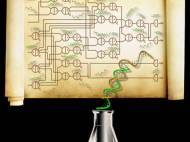Caltech researchers made the largest synthetic DNA biochemical circuit yet
 Researchers at the California Institute of Technology (Caltech) have built the currently most complex biochemical circuit created from scratch, made with DNA-based devices in a test tube. Engineering these circuits allows researchers to explore the principles of information processing in biological systems, and to design biochemical pathways with decision-making capabilities.
Researchers at the California Institute of Technology (Caltech) have built the currently most complex biochemical circuit created from scratch, made with DNA-based devices in a test tube. Engineering these circuits allows researchers to explore the principles of information processing in biological systems, and to design biochemical pathways with decision-making capabilities.
“We’re trying to borrow the ideas that have had huge success in the electronic world, such as abstract representations of computing operations, programming languages, and compilers, and apply them to the biomolecular world”, said Lulu Qian, a senior postdoctoral scholar in bioengineering at Caltech.
Along with Erik Winfree, Caltech professor of computer science, computation and neural systems, and bioengineering, Qian used a new kind of DNA-based component to build the largest artificial biochemical circuit so far. The researcher’s approach involves components that are simple, standardized, reliable, and scalable, thus enabling bigger and more complex circuits which can work reliably.
Biochemical circuits consist of molecules floating in a test tube of salt water. Instead of depending on electrons flowing in and out of transistors, DNA-based logic gates receive and produce molecules as signals. The molecular signals travel from one specific gate to another, connecting the circuit as if they were wires.
Winfree and his colleagues made a simpler and less efficient biochemical circuit in 2006. In their new design, Qian and Winfree have engineered logic gates that are simpler and more reliable, allowing them to make circuits at least five times larger. Their new logic gates are made from pieces of either short, single-stranded DNA or partially double-stranded DNA in which single strands stick out like tails from the DNA’s double helix. The single-stranded DNA molecules act as input and output signals that interact with the partially double-stranded ones.
“The molecules are just floating around in solution, bumping into each other from time to time”, said Winfree. “Occasionally, an incoming strand with the right DNA sequence will zip itself up to one strand while simultaneously unzipping another, releasing it into solution and allowing it to react with yet another strand.”
The researchers made several circuits with their approach, but the largest (containing 74 different DNA molecules) can compute the square root of any number up to 15 (a four-bit binary number) and round down the answer to the nearest integer. The researchers then monitor the concentrations of output molecules during the calculations to determine the answer. The calculation takes about 10 hours, but the purpose of these circuits isn’t to compete with electronics – rather providing the logical control over biochemical processes.
In order to counter the noise (because reactions are never perfect), the logic gates are suppressing and amplifying signals (for example, boosting a signal that’s at 80 percent, or inhibiting one that’s at 10 percent). Since all the logic gates have identical structures with different sequences, they can be standardized and wired together to make any desired circuit. The researchers even provided an online compiler which translates a desired circuit design into the DNA components needed to build it.
The circuit components are also tunable. By adjusting the concentrations of the types of DNA, the researchers can change the functions of the logic gates. The circuits are versatile, featuring plug-and-play components that can be easily reconfigured to rewire the circuit. The simplicity of the logic gates also allows for more efficient techniques that synthesize them in parallel.
These circuits could provide biochemists with unprecedented control in designing chemical reactions for applications in biological and chemical engineering and industries. In future, a synthetic biochemical circuit could be introduced into a clinical blood sample, detect the levels of a variety of molecules in the sample, and integrate that information into a diagnosis of the pathology.
For more information, read the article published in the journal Science named: “Scaling up digital circuit computation with DNA strand displacement cascades“.









Leave your response!